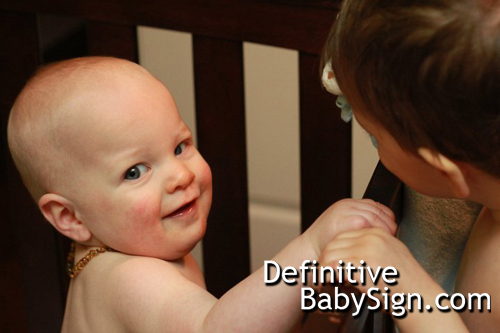 I tug my boys arm when he’s upset, get done to his level, establish eye contact and lower my voice and unemotionally ask him what’s the matter. If he’s out of breath I tell him to “be calm” – he’ll exhale (a trick we learned early on). If he can’t talk I ask him to do it again. If we’re in a stimulating environment we might move to a quieter location to sort the matter out. Then we insist again that words be used to explain the problem and I make sure to listen carefully. If words aren’t forthcoming, I ask for signs and try to piece together the matter. I fill in the blanks and turn what my son has said into a sentence and repeat it back to him. Then I do it again in a question – usually it’s a request, something he wants to do. Now I either fulfill the request, or deny it with a reasonable reason. This sequence works every time to resolve toddler issues, but doesn’t happen overnight.
I tug my boys arm when he’s upset, get done to his level, establish eye contact and lower my voice and unemotionally ask him what’s the matter. If he’s out of breath I tell him to “be calm” – he’ll exhale (a trick we learned early on). If he can’t talk I ask him to do it again. If we’re in a stimulating environment we might move to a quieter location to sort the matter out. Then we insist again that words be used to explain the problem and I make sure to listen carefully. If words aren’t forthcoming, I ask for signs and try to piece together the matter. I fill in the blanks and turn what my son has said into a sentence and repeat it back to him. Then I do it again in a question – usually it’s a request, something he wants to do. Now I either fulfill the request, or deny it with a reasonable reason. This sequence works every time to resolve toddler issues, but doesn’t happen overnight.
Every parent has a connection with their baby after having spent their baby’s entire lifetime with them. This is natural, but knowing what makes a baby and toddler tick is something entirely different and this is up to you to discover.
When my son was under 12 months, I’d often calm him for sleeping. It was pretty easy for me after I discovered that he was needing of security. I held his chest as he lie on his back with consistent pressure. This makes him feel safe and hugged without having to take him out of the bed. The same can be done by swaddling and this is a good thing to do when baby is really young because the “hug” doesn’t go away. I then add key words and phrases. “Shushing” can work great and is thought to replace the sounds a baby heard while in the womb. I’m not sure this is exactly the reason it works, but after doing it enough times, it becomes a sound of security in and of itself. I call these keys “mind string” because they tug on the “strings of the mind” in such a way as to elicit responses which are desirable. The shushing pulls on the mind in just the right way to produce a calming effect. You can make any keys you want. Many parents will say “Shhhhh, you’re okay, shhhh, you’re okay” and repeat this over and over again. By hearing it, your baby understand what follows i.e. they calm and fall asleep. The string pulls on the mind to elicit subsequent behaviours.
As you and your baby grow close, you’ll have all sorts of mind strings working in your favour. At least the most effective parents will, the lesser effective parents will tackle parenthood in some random fashion.
“Guiding” is another type of mind string. As adults when someone puts their hand on our lower back, we go where they lead us. Our parents started this mind string and later when someone else does it, we do it too. Try this, put your hand out to someone, even a stranger and they’ll immediately put their hand out to catch yours. Unless it’s really weird, it happens. I recall several elderly people doing this to me as they sought to direct me in one location or another. Guiding by putting out your hand can help you get a toddler in motion – to pick up toys or to follow you to another location on a walk.
Give mind strings a shot with your toddler and see what kinds of behaviours you can elicit from your baby. It’s really a great skill to learn to help make parenting easier.
